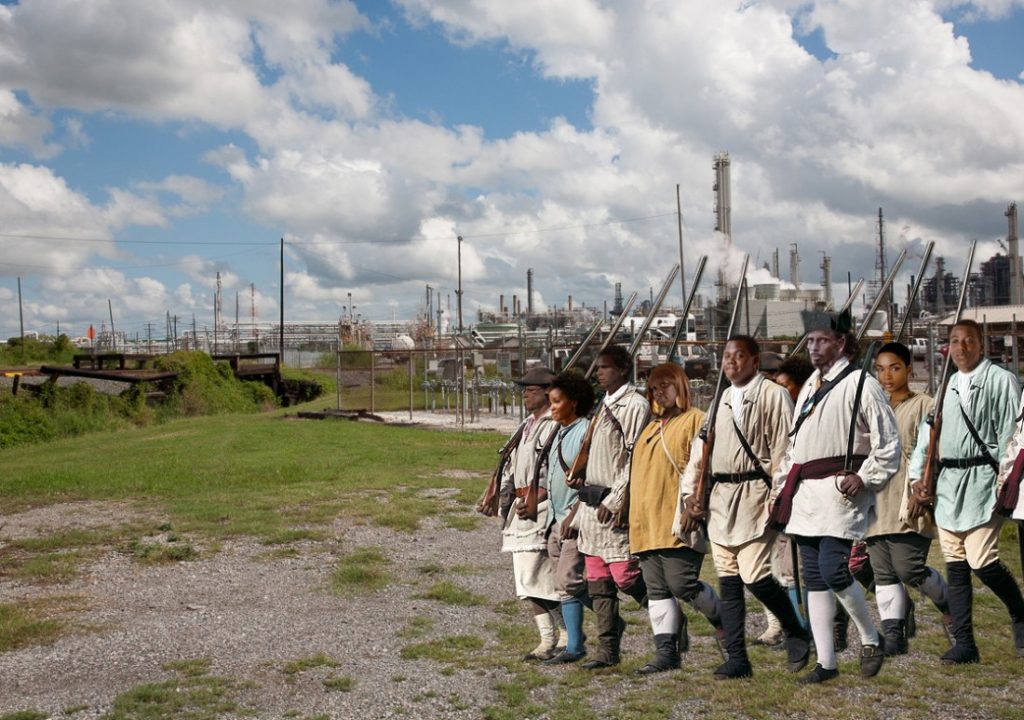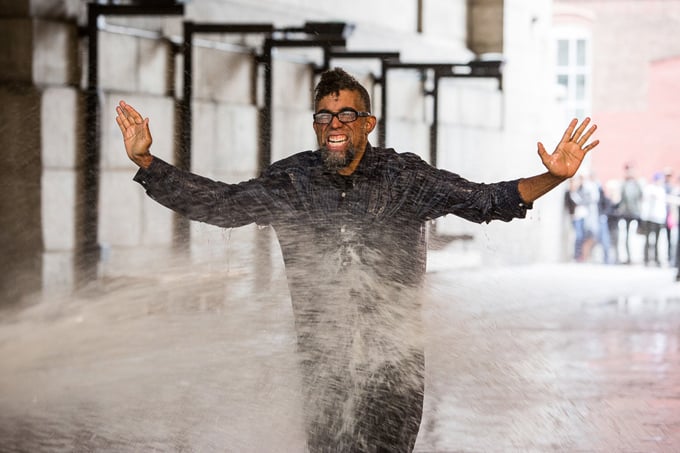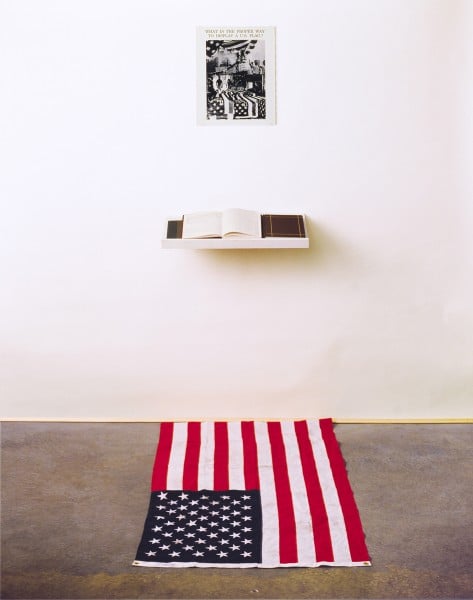People
Dread Scott Wants You to Rise Up Against Slavery
While it's rooted in slavery, it's about emancipation.

While it's rooted in slavery, it's about emancipation.

Brian Boucher

During a rainy evening on January 8, 1811, while plantation owners were consumed with preparations for Mardi Gras, more than 200 slaves attacked their owners and oppressors in an area north of New Orleans known as the German Coast, which the US had recently acquired in the Louisiana Purchase. Dressed in stolen militia outfits and wielding muskets, blunderbusses, and cane knives, some of them astride horses, the slaves killed a local plantation owner, burned planters’ estates, and struck fear into the heart of the area’s white population, who were vastly outnumbered.
A few days later, the uprising, which was now 500 strong, was extinguished by a combination of armed planters, borrowed American soldiers, and seamen. The rebels were severely punished after a series of horrifying show trials. Decaying corpses and slaves’s heads on stakes permeated the air along the Mississippi River for some time afterward.
As recent fights over the Confederate Flag suggest, the past is far from dead. April marked the 150th anniversary of the end of the Civil War, but New York artist Dread Scott wants to take you back even farther along in American history to that lesser-known 19th-century New Orleans slave uprising—the largest of its kind in what would become the United States.
Sometime during the first part of 2017, a small army of reenactors in historical costumes will walk the 25-mile path of these rebels, who were headed to New Orleans, planning, as a rebel called Jupiter put it when he was later interrogated, “to kill the whites,” Scott said during an interview. Their travels will take them through an area that, Scott says, includes not only gated communities but also strip malls and trailer parks. There are also enough industrial plants to form a “petrochemical corridor” that has given rise to so much illness as to be dubbed “Cancer Alley” by the media.
“This rebellion, while not likely to succeed, actually had a potential for success,” Scott said. “And success, for the rebels, was defined not just as ‘Kill some white people and escape to the swamps.’ Success was ‘Seize the city of New Orleans and end slavery.’”
Just a few years earlier, slaves had defeated the French colonists in Haiti, and Scott imagines that the German Coast slaves hoped, similarly, to establish an African republic.
“It was a profoundly bold vision,” Scott said.
The project has been in the works for some time already; in 2013, it received initial support from the McColl Center for Art + Innovation, in Charlotte, North Carolina, in the form of a residency, and it is benefiting from ongoing funding from New York nonprofit A Blade of Grass, which will also produce a documentary film on the piece.

Dread Scott, On the Impossibility of Freedom in a Country Founded on Genocide and Slavery (2014).
Photo © Mark Von Holden for More Art.
The Long Legacy of Slavery
Scott, whose nom d’artiste echoes that of Dred Scott, a slave who unsuccessfully sued for his freedom in 1857, has taken a hard look at disenfranchisement in the US. His 2012 video installation Stop gives voice to young black men who are repeatedly stopped and frisked by police; he interviewed prison inmates for his photo-and-audio work Lockdown (2000-04); in his 2014 performance On the Impossibility of Freedom in a Country Founded on Slavery and Genocide, he enlisted a fireman to blast him with a fire hose, a tactic police employed against Civil Rights-era protesters in the US.
But if Scott is known for one thing, it may be What is the Proper Way to Display a US Flag?, a 1989 work that invited visitors to tread on the Stars and Stripes as it rested on the floor near photos of flag-burning protests and flag-draped coffins. That piece earned the artist the rare distinction of having his work labeled “disgraceful” by President George H.W. Bush. Scott was then still a student at the Art Institute of Chicago; he would later attend the Independent Study Program at New York’s Whitney Museum of American Art.

Dread Scott, What is the Proper Way to Display a US Flag? (1988).
Photo via DreadScott.net.
Scott’s project comes along at the same time that, after the police killings of Michael Brown, Eric Garner, and many others, there is a modern uprising against racism in the form of the Black Lives Matter movement. Just before the deaths of Brown and Garner, writer Ta-Nehisi Coates’ award-winning Atlantic article “The Case for Reparations” brought to the fore the notion that America might consider making right for its ugly past, both distant and recent.
Many contemporary artists, like Glenn Ligon, Hank Willis Thomas, Kara Walker, and Fred Wilson, address slavery in their work; artist-filmmaker Steve McQueen won an Oscar for his feature film 12 Years a Slave, which told the story of Solomon Northup, a free black man who was kidnapped and sold into bondage. For Scott, though, considering that America’s foundation relied on the plunder (as Coates calls it) of blacks’ bodies and possessions, the attention paid to it among artists today is far too little, he told me.
Even those obsessed with the Civil War often avoid the issue. Scott’s project echoes, in a telling way, the peculiar tradition of Civil War reenactments, which tend to focus on historical accuracy in details like clothing but often manage to sidestep the issue of race. When the New Yorker’s Tony Horwitz visited some reenactors in 1998, he found that “the awkward racial questions surrounding allegiance to the South didn’t intrude.” Allison Smith’s 2005 public art project The Muster similarly focused on the kitschy aesthetics of Civil War reenactment, referring to the conflict in only the most oblique way—by asking participants to answer the question, “What are you fighting for?”
How to Start an Uprising
Kook and Quamana, two slaves who were held by the American planter James Brown (sorry, Godfather of Soul), were responsible for enlisting many of the rebels, author Daniel Rasmussen writes in his 2011 book, American Uprising: the Untold Story of America’s Largest Slave Revolt. Also pivotal, he writes, was the involvement of the half-white slave Charles Deslondes, who served as a slave driver for the Spanish planter Manuel Andry and used his relative freedom of movement and association to recruit other slaves. Plans for the uprising spread during furtive conversations among men and women who knew that it could mean their lives if they confided in the wrong person.
As those hushed conversations were pivotal to the rebellion, exchanges among the participants are key to the success of Dread’s project, as he sees it. But he doesn’t plan to dictate what those talks might touch on. While the artist is open to the idea that people might join the project because of, say, their opposition to mass incarceration, he’ll let the conversations take their own course.
Some of those discussions may be in a more formal setting than the period-appropriate tents, among participants wrapped in wool blankets. Ron Bechet, chair of the art department at Xavier University of Louisiana, plans to teach a course based on the uprising and Scott’s project, says the artist, who is eager to attract young participants. They’re more likely, he thinks, to be open to big questions. It also happens that college-age people constituted many of the slaves in the area’s sugar trade, which demanded physical strength, and where few slaves survived more than a few years.
“This is where the 21st century meets the 19th century,” Scott told me. “That’s where I think this project will be very fertile.”
He hopes the conversations will be as bold as were the dreams of rebellion leaders Kook, Quamana and Deslondes. “If we approach today’s problems with that kind of vision,” he said, “that would matter tremendously.”
His youthful participants, he went on, are likely to be thinking, “Can we get free? And what would that mean? So while this project is rooted in slavery, it’s actually about freedom and emancipation.”